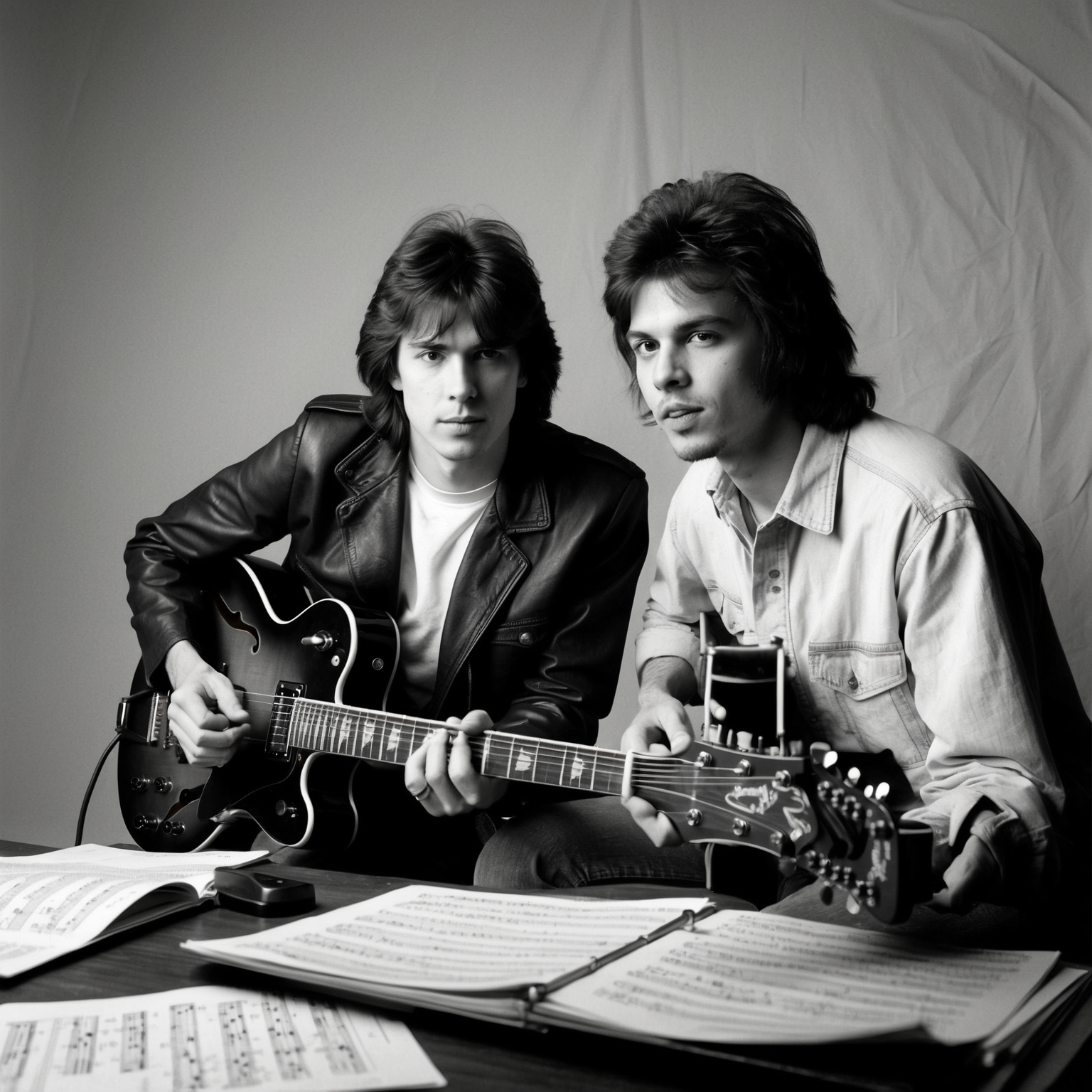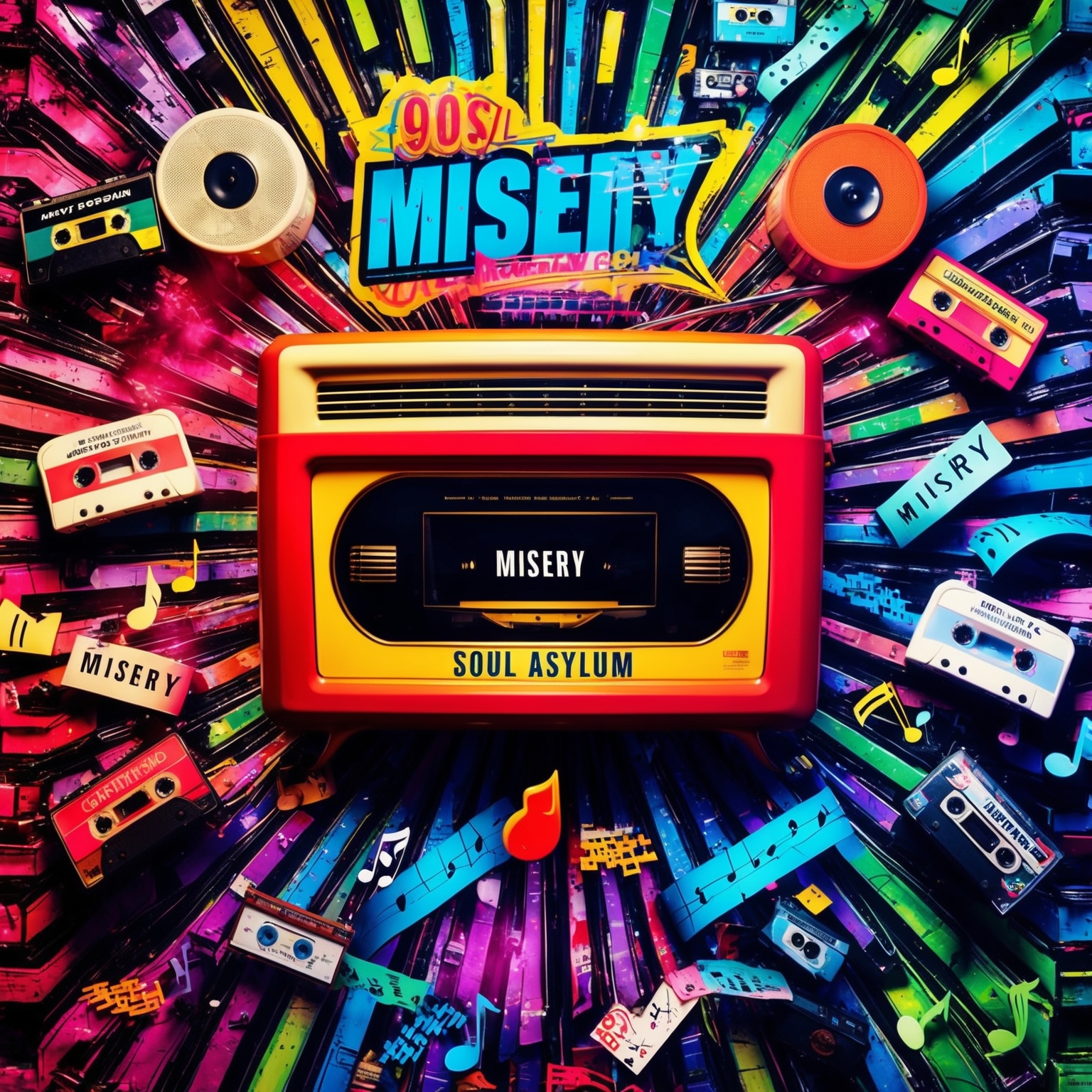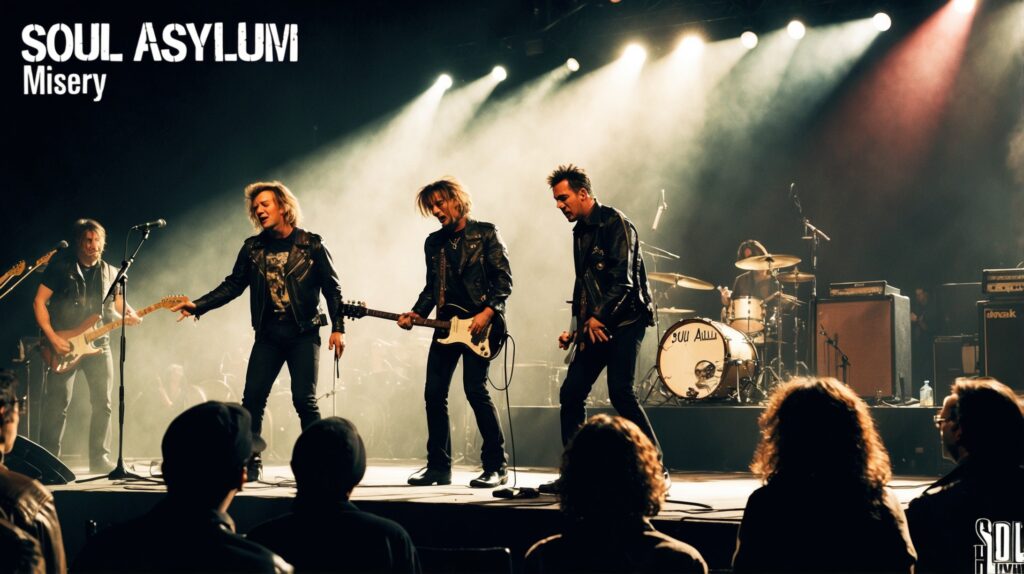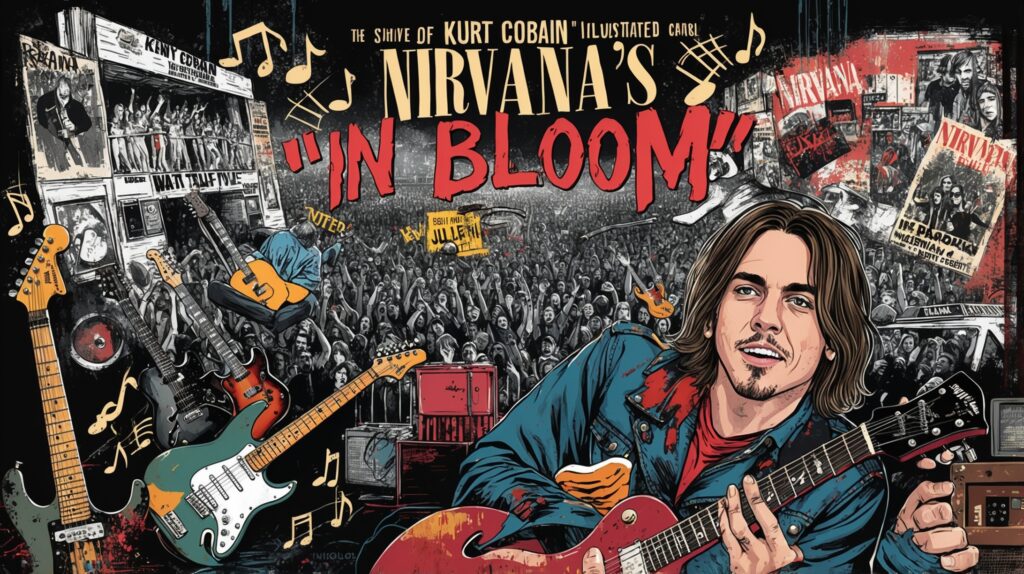Soul Asylum: From Underground Roots to Mainstream Success
Explore the journey of Soul Asylum, the band behind the iconic track “Misery,” as they transitioned from underground icons to mainstream success in the 1990s music scene.

Soul Asylum, the band behind the poignant track “Misery,” holds a crucial place in the tapestry of American alternative rock. Formed in Minneapolis, Minnesota in 1981, the band spent much of the 1980s touring tirelessly and building a devoted fan base with their raw and energetic live performances. Their early sound was deeply rooted in punk and post-punk influences, which eventually evolved into the more melodic and mainstream appeal that brought them widespread recognition in the 1990s. “Misery,” released in 1995 as part of their album Let Your Dim Light Shine, came at a time when Soul Asylum was riding a wave of success, following their breakthrough with the album Grave Dancers Union.
Soul Asylum’s path to fame wasn’t instantaneous. The band’s journey through the 1980s was filled with both struggle and perseverance. Band members at the time of “Misery” included the charismatic lead vocalist and guitarist Dave Pirner, lead guitarist Dan Murphy, bassist Karl Mueller, and drummer Sterling Campbell. Each member contributed to the band’s dynamic sound and live presence. By the time “Misery” hit the airwaves, Soul Asylum had already garnered a reputation for their emotionally resonant storytelling and a knack for crafting songs that captured the zeitgeist of their era.
In the context of the mid-’90s music scene, Soul Asylum played an essential role in bridging the gap between the grunge explosion and the burgeoning alt-rock movement. “Misery,” with its introspective lyrics and infectious chorus, was emblematic of that era’s penchant for dissecting complex emotional landscapes. The song’s creation reflected the band’s ability to blend somber themes with catchy melodies, a skill that set them apart from their peers. As for collaborations, throughout their career, Soul Asylum worked with a variety of producers and artists, which further enriched their musical palette and facilitated their ability to adapt and thrive in the rapidly changing musical landscape of the time.
The Creative Mind Behind ‘Misery’: Dan Murphy and Dave Pirner
Dan Murphy and Dave Pirner of Soul Asylum are the creative forces behind the composition of ‘Misery’. Their collaborative efforts in melding melody and lyrics have formed a resonant track that epitomizes both their musical synergy and individual talents.

The song ‘Misery’ by Soul Asylum has etched itself into the annals of rock music, due in no small part to the creative prowess of its composers—Dan Murphy and Dave Pirner. Both founding members of the band, Murphy and Pirner have been instrumental in crafting the distinctive sound that defines not only this song but Soul Asylum’s entire musical repertoire. Their collaborative synergy is evident in how they blend melody with poignant lyrics, creating a track that resonates with audiences on multiple levels.
Dan Murphy’s background in music is as rich as it is varied. His guitar playing often draws from a myriad of influences, ranging from classic rock stalwarts to the more unconventional chords found in alternative rock. Murphy’s contribution to ‘Misery’ can be seen in the intricate layering of guitar riffs that give the track its raw, dynamic energy. His style is complemented perfectly by Pirner’s approach, showcasing a partnership where each complements the other’s strengths.
Dave Pirner’s role in creating ‘Misery’ extends beyond that of a composer; he is also the band’s lead vocalist and lyricist. His lyrical approach channels emotive storytelling, and in ‘Misery,’ he captures themes of existential angst and the search for meaning. The interplay between his lyrics and the melodic framework provided by Murphy exemplifies how they achieve a balanced musical tapestry. This not only highlights Pirner’s vocal prowess but also demonstrates his profound ability to connect with listeners through words.
In collaboration, Murphy and Pirner have forged a piece that is much more than the sum of its parts. Their efforts in crafting ‘Misery’ have ensured that it stands out not only as a central piece in Soul Asylum’s discography but as a significant contribution to the rock genre as a whole.
The Impact and Recognition of ‘Misery’
While ‘Misery’ by Soul Asylum might not have garnered extensive awards, its influence and cultural impact are undeniable. Recognized for its lyrical depth, the song has made appearances in TV series and movies, embedding itself into the fabric of popular culture.

Soul Asylum’s ‘Misery’ may not have garnered an extensive array of awards, but it left an indelible mark on the musical landscape of the mid-1990s. Released as one of the spotlight tracks from their fifth studio album, ‘Let Your Dim Light Shine,’ the song resonated with both critics and fans alike. Despite the competitive musical environment at the time, ‘Misery’ stood out with its introspective lyrics and powerful composition.
The song did not receive major awards like the Grammys, yet it was recognized for its songwriting finesse and lyrical depth. Critics praised its raw and emotional take on the themes of struggle and disappointment, often highlighting it as a defining track of the era. Though not laden with awards, the song’s influence was evident in its persistent airplay on rock radio stations and its standing as a fan favorite during live performances.
While not widely covered by other artists, ‘Misery’ has made its way into various cultural settings, enriching its influence beyond the charts. The track was featured in episodes of popular television series, further embedding it into the consciousness of its audience. Moreover, its inclusion in the soundtracks of various films and ads has helped maintain its relevance over the years, introducing it to new generations of listeners.
Overall, while ‘Misery’ may not have an extensive list of accolades, its cultural impact and resonance with listeners remain its most notable achievements. Its enduring appeal and the raw honesty it delivers through music continues to keep the song alive in the hearts of many.
Unraveling the Chart Journey of ‘Misery’ by Soul Asylum
Discover how ‘Misery’ by Soul Asylum conquered the charts and left an indelible mark. Released in February 1995, it quickly climbed to #20 on the Billboard Hot 100.

Released on February 21, 1995, ‘Misery’ was the lead single from Soul Asylum’s album, Let Your Dim Light Shine. The song marked a distinct moment in the band’s career, following the massive success of their previous album, Grave Dancers Union, and its hit single ‘Runaway Train’. Soul Asylum had set high expectations for themselves, and ‘Misery’ needed to resonate with a wide audience to maintain their momentum. The initial chart performance was a testament to its appeal, as it quickly climbed to #20 on the Billboard Hot 100, demonstrating its widespread acceptance.
Compared to other tracks of the time, ‘Misery’ held its own amidst a diverse musical landscape. The mid-90s saw the rise of various genres, and while grunge and alternative rock continued to dominate, pop, hip-hop, and R&B were also gaining substantial traction. Despite such competition, the song’s catchy chorus and relatable lyrics allowed it to resonate with fans across different musical tastes, solidifying its place among the notable hits of that era.
From a marketing perspective, the promotion for ‘Misery’ was strategically curated. The track was heavily featured in radio playlists, and MTV played a pivotal role in pushing the song through its frequent rotation of the music video. Its airplay on both radio and television significantly contributed to its chart success. In addition to its thorough promotion, the song benefited from the existing fandom established by ‘Runaway Train’, which helped in cementing its chart presence. Critics and fans alike often praised ‘Misery’ for its catchy progression and poignant lyrics, which added weight to its cultural impact and ensured Soul Asylum’s continued relevance in the music scene.
Visual Interpretation of ‘Misery’
The music video for ‘Misery’ is a serene yet powerful visual interpretation that mirrors the song’s introspective themes, reinforcing its emotional resonance without overshadowing the band’s performance.

The music video for Soul Asylum’s ‘Misery’ is a classic representation of the band’s gritty and authentic style. Although not as iconic as some of their other visual works, it plays a vital role in encapsulating the song’s essence. The video is often praised for its raw and honest depiction, aligning with the song’s themes of struggle and searching for meaning amidst the chaos of life.
While the video didn’t necessarily propel the song to additional heights of fame, it reinforced the emotional weight carried by the lyrics and melody. The visuals complement the song’s contemplative tone by featuring dimly lit scenes and poignant imagery that reflect the existential turmoil expressed in the lyrics. Its understated approach allowed the song to shine, avoiding any distractions that more extravagant visuals might have introduced.
The production team behind the video ensured that it stayed true to the band’s artistic vision. Though there are no celebrity cameos, this choice emphasizes the focus on the band members themselves, highlighting their performance and connection to the song. Critical reception to the music video has been positive, noting its effectiveness in retaining the authenticity and sincerity that Soul Asylum is known for, and its contribution to solidifying the band’s place in the rock music scene of the ’90s.
Unraveling the Sonic Architecture of ‘Misery’
Explore the intricate musical structure of Soul Asylum’s ‘Misery’, shedding light on its key, chord progression, and melodic elements.

‘Misery’ by Soul Asylum stands out as a quintessential 90s alternative rock anthem, with its unique blend of musical elements that capture both the spirit of the era and the band’s distinctive sound. The song is typically set in a minor key, which contributes to its somber yet compelling atmosphere, a hallmark of much of the band’s work during this period. The chord progression is relatively straightforward, yet it is the subtle complexities in the arrangement and instrumentation that elevate the song.
The tempo of ‘Misery’ is moderate, aligning with the brooding lyrics and reflective mood of the song. The melody carries a melancholic, yet engaging quality, drawing the listener in with its emotive power. The harmony is layered and rich, showcasing the band’s ability to craft a sound that is both dense and dynamic. Rhythmically, the song is driven by steady percussion patterns that provide a solid foundation for the melodic and harmonic elements to interplay.
Instrumentally, ‘Misery’ features a combination of electric guitars, bass, and drums, with occasional use of keyboard elements to add depth and texture. The guitars, in particular, play a vital role with their grunge-influenced, distorted riffs, which are softened by melodic interludes. In the context of Soul Asylum’s discography, ‘Misery’ signifies a mature point in their evolution, reflecting a shift towards more introspective themes compared to earlier, more rebellious works. This progression is mirrored in the band’s exploration of complex musical compositions and polished production.
An interesting anecdote from the recording sessions highlights the band’s collaborative spirit. The song was produced by the renowned producer Butch Vig, known for his innovative touch on iconic albums like Nirvana’s ‘Nevermind’. Vig’s input helped to refine the sound of ‘Misery’, steering it towards a polished, radio-friendly yet deeply authentic rock sensation.
Exploring the Depths of ‘Misery’ by Soul Asylum
An in-depth exploration of the lyrical themes, narrative structure, and literary devices in Soul Asylum’s ‘Misery.’ This analysis delves into how the song portrays shared human distress through its poignant and clever wordplay.
Loves company
We could start a company
And make misery
Frustrated Incorporated
Well I know just what you need
I might just have the thing
I know what you’d pay to see
Put me out of my misery
I’d do it for you, would you do it for me?
We will always be busy making misery
…
******* This Lyrics is NOT for Commercial use *******

At the heart of Soul Asylum’s song ‘Misery’ lies a tapestry of complex themes and resonant messages, wrapped in clever wordplay and rich narrative style. The lyrics dive into the unsettling embrace of unhappiness, often using irony and satire to examine how discomfort becomes a shared human experience. The opening lines, ‘They say misery / Loves company / We could start a company / And make misery,’ immediately introduce the concept of turning common distress into a commercial entity. This clever twist highlights the pervasive nature of unhappiness while underscoring society’s tendency to profit from emotional anguish.
Narratively, the song employs a first-person perspective, creating an intimate connection with the listener, as if the singer is confiding directly in them. This approach not only makes the lyrics more relatable but also deepens the song’s impact. The repetition in lines like ‘We will always be busy making misery’ underscores a sense of perpetuity, suggesting that misery is an inevitable part of life that one comes to accept and navigate.
The use of literary devices is apparent throughout, with alliteration, as seen in ‘Frustrated Incorporated,’ which adds a rhythmic flow while emphasizing the song’s theme of organized despair. The song cleverly uses metaphors to equate the proliferation of sorrow with a bustling corporation. This presents a stark commentary on modern life’s complexities and how individuals often feel trapped in cycles of dissatisfaction. Moreover, these metaphors draw a connection to industrial society, where personal grievances can feel like mechanized, profit-driven entities in themselves.
Feeling down? Misery by Soul Asylum predicted our futures—Frustrated Incorporated, anyone? ? Plus, it hit #20 on the Billboard in ’95! ? #ThrowbackThursday https://bit.ly/4ihQp3X
Click to Tweet







